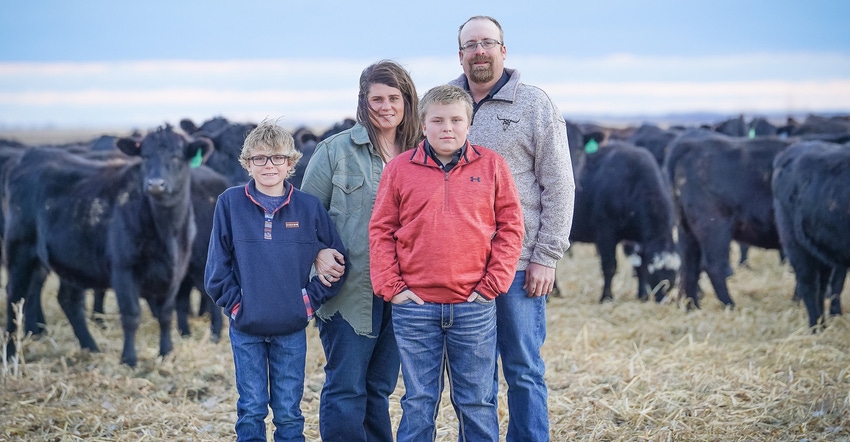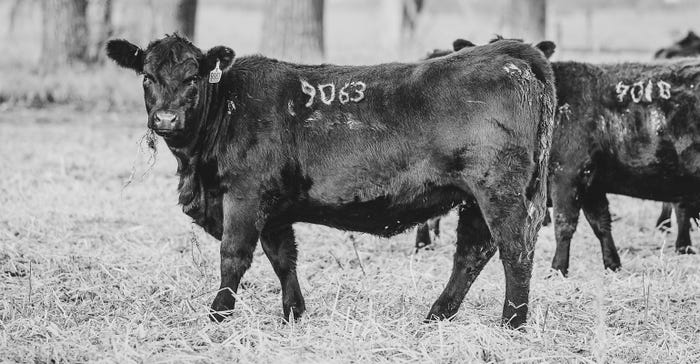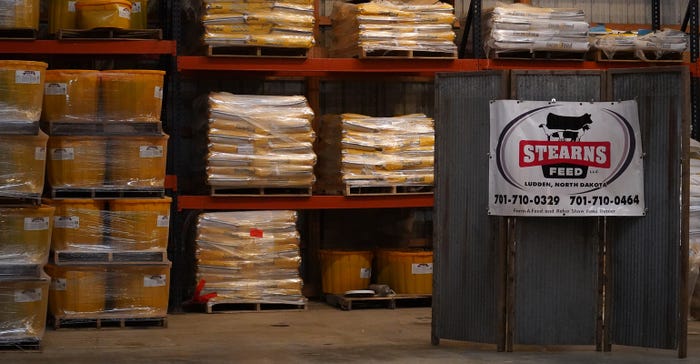January 11, 2021

When cattle grade Prime, producers are doing something right. For the Stearns Ranch near Ludden, N.D., it involves tracking nutrition and improving herd genetics.
Stearns Ranch was recently named Commercial Breeder of the year by the North Dakota Angus Association. It is a multi-generational operation in the southeastern region of the state. Fifth-generation rancher Dylan Stearns runs the day-to-day operation along with his wife, Meagan; their sons, Stetson and Sutton; and Dylan’s parents, Spencer and Jayne Stearns.
The family focuses on raising quality Angus cattle in a cost-effective manner, which includes using hoop barns. Still, they look to new technology to create a consistent product for buyers, whether in the meat case or as live animals.
Advancing with technology
Four years ago, Dylan implemented Performance Beef software, produced by Performance Livestock Analytics, with a goal to simplify their operation and continue working toward consistency and efficiency throughout the herd.
“No more feed sheets blowing through the wind or sitting on my desk waiting to be entered,” Dylan says.
The technology tracks feed records, including timing, rations and ingredients, as well as detailed health information and daily gains for each individual. Cattle wear ear tags that are read by a scanner on a chute, iPad or cellphone. They are evaluated for efficiency, and the data collected helps identify those who are not performing well. These animals are then culled from the herd.
This attention to detail has built a physical look of consistency within the herd and helped the Stearns cattle achieve a Prime carcass rating at slaughter. It has also simplified the operation and saved the Stearns family time and money.

Dylan can evaluate the cost of feed and cost per head on a daily basis by inputting current market information. This helps with profitability and decision-making regarding when to sell calves.
“He can punch in a sale price and it will tell him right now what his profit is. Whether it’s better to sell now or fatten them,” Meagan says.
“It’s the epitome of what commercial Angus breeders should be looking at doing,” says Paul Topp, owner at Topp Angus. “This focus on all areas of production, not just the genetics, but collecting the kill data and understanding what the consumer wants and how it all ties into the profitability of their place is something everyone should strive for.”
All in on genetics
The Stearns recognize the importance genetics play in ranch profitability. They want cattle that are efficient in feed conversion, are consistent in body type and have strong maternal traits. To reach these goals, they look at the genetics of not only the momma cows, but also the bulls.
“You have to work with your vet, your nutritionist and your bull guy to get everything lined up — to make everything click. If you skimp out on one of them, it will cost you dearly,” Dylan says.
Stearns Ranch has been purchasing bulls from Topp Angus, Grace City, N.D., for 12 years. They have used these genetics to grow their females from 150 calving per year to 600. The Stearns retain about 100 heifers each year and sell commercial bred heifers at the Topp Angus annual sale each February.
“I think growing their cow herd has been very strategically done in regard to improving quality while increasing numbers. The attention to detail in genetic selection within their cow herd has been top-notch,” Topp says.
This year they had a 96% pregnancy rate — and “90% of that was in the first 30 of the 60 days,” Dylan says.
It takes a family approach to selecting bulls that work. Stetson and Sutton look at the bull catalog and have a hand in all the decision-making, according to their mom, Meagan.
“I would not be where I’m at without these two,” Dylan says of his sons. “They are just as important in our operation.”
Still, it takes more than genetics to keep cows in top condition.
Don’t skimp on nutrition
High-quality feed and chelated minerals help ensure reproductive success and give the genetics an opportunity to thrive in the best environment possible.
“Mineral is always the first thing to get cut, because it’s expensive,” Meagan says, “but it’s really the cheapest thing you can feed to keep your cow herd healthy and productive.”
Megan understands the needs of her cattle and the importance of nutrition on the ranch. She has a small-grain business with her dad in Groton, S.D. The family also operates Stearns Feed in Oakes, N.D., a feed and mineral dealership, along with growing corn, soybeans, rye, alfalfa and oats in their farming operation.
They develop a feed ration that suits their cattle and operation.
Look to low-cost housing
The Stearns have a unique approach to calving heifers and finishing cattle using hoop barns. The weather in this area of the state is often wet, forcing cattle indoors. The family cannot operate with feedlots open to the weather elements.
The hoop barns offer increased light and natural airflow compared to a traditional steel building. In addition, it keeps the cows dry, increasing their comfort and health.

Manure is collected from the hoop barns, composted and spread on silage ground. Soil samples are taken from around the barns and on silage ground yearly to ensure environmental standards are met.
The family likes this type of housing system as it allows the ranch to care for both cows and land. But proper housing is just one aspect of raising quality cows and calves.
Advice for others
Dylan and Meagan not only share their passion for agriculture with their sons, but also strive to educate and invite the public to see their operation firsthand.
Local school groups tour their farm and ranch, learning about production, and the Stearns donate beef to a local youth culinary class. These kinds of interactions with the public allow the Stearns to make a connection between farm and table, and drive home the idea that food doesn’t just come from a can or box.
The family says its recipe of quality genetics, proper nutrition and cow comfort is one to build on for future. The couple wants to see the next generation return to the farm and continue producing cattle that grade the best in the business.
Johnson writes from New England, N.D.
You May Also Like




